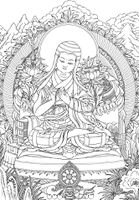Sa skya paN+Di ta
Jump to navigation
Jump to search

ས་སྐྱ་པཎྜི་ཏ་
| Wylie | sa skya paN+Di ta |
|---|---|
| English Phonetics | Sakya Paṇḍita |
| Sort Name | Sakya Paṇḍita |

Line Drawing by Robert Beer Courtesy of The Robert Beer Online Galleries
Other names
- ཀུན་དགའ་རྒྱལ་མཚན་
- ས་སྐྱ་པཎྜི་ཏ་ཀུན་དགའ་རྒྱལ་མཚན་
- kun dga' rgyal mtshan
- sa skya paN+Di ta kun dga' rgyal mtshan
Alternate names
- Sapaṇ
- Sapen
- Sapan
Dates
| Birth: | 1182 |
|---|---|
| Death: | 1251 |
Tibetan calendar dates
| Day | |
|---|---|
| Month | |
| Gender | Male |
| Element | Water |
| Animal | Tiger |
| Rab Jyung | 3 |
| Day | |
|---|---|
| Month | |
| Gender | Female |
| Element | Iron |
| Animal | Pig |
| Rab Jyung | 4 |
About
- Religious Affiliation
- Sakya
- Familial Relations
- Grandson of Sa chen kun dga' snying po and nephew of rje btsun grags pa rgyal mtshan and bsod nams rtse mo, and uncle of chos rgyal 'phags pa.
- Teachers
- Śākyaśrībhadra · rje btsun grags pa rgyal mtshan
- Students
- gu ru chos kyi dbang phyug · chos rgyal 'phags pa · yang dgon pa rgyal mtshan dpal · lho pa kun mkhyen rin chen dpal
Other Biographical info:
Links
- BDRC Link
- https://www.tbrc.org/#!rid=P1056
- Treasury of Lives Link
- http://treasuryoflives.org/biographies/view/Sakya-Pan%E1%B8%8Dita-Kunga-Gyeltsen/2137
- Treasury of Lives Excerpt
- Sakya Paṇḍita Kunga Gyaltsen, commonly referred to as Sapaṇ, was the fourth of the Five Patriarchs of Sakya and the sixth Sakya throne holder. A member of the illustrious Khon family that established and controlled the Sakya tradition, he was an advocate for strict adherence to Indian Buddhist traditions, standing in opposition to Chinese or Tibetan innovations that he considered corruptions. In this regard he was a major player in what has been termed the Tibetan Renaissance period, when there was a move to reinvigorate Tibetan Buddhism’s connections to its Indian antecedents. He was instrumental in transmitting the Indian system of five major and five minor sciences to Tibet. As an ordained monk, Sapaṇ was instrumental in laying the groundwork for adherence to the Vinaya at Sakya Monastery, built under his successors. He authored more than one hundred texts and was also a prolific translator from Sanskrit. His writings are among the most widely influential in Tibetan literature and prompted commentaries by countless subsequent authors. Sapaṇ’s reputation as a scholar and Buddhist authority helped him forge close ties with powerful Mongols, relations that would eventually lead to the establishment of Sakya Monastery and its position of political power over the Thirteen Myriarchies of central Tibet.
- Himalayan Art Resources Link or Other Art Resource
- https://www.himalayanart.org/search/set.cfm?setID=325
- Wiki Pages
- Sa skya paN+Di ta on the DRL
- Sa skya paN+Di ta on the LIB
- Sa skya paN+Di ta on the DNZ
- Sa skya paN+Di ta on the BNW
Buddha Nature Project
- Person description or short bio
Expand to see this person's philosophical positions on Buddha-nature.
| Is Buddha-nature considered definitive or provisional? | |
|---|---|
| Position: | Provisional |
| Notes: | *Kano, K., Buddha-Nature and Emptiness, p. 309.
|
| All beings have Buddha-nature | |
| Position: | Qualified No |
| If "Qualified", explain: | There is some discrepancy between Sapen's use of the term tathāgata-essence and buddha-nature and other thinkers that use these terms synonymously. In Sapen's view, sentient beings do not possess the former, but do possess a more general form of the latter. So while the answer is a qualified "no" in terms of the more general debate on this issue and the way others have addressed it and asserted Sapen's position, strictly speaking from Sapen's view the answer could more accurately be a qualified "yes" as he does state all beings have a basic "inherent" buddha-nature, though this does not correspond to an essence that is endowed with enlightened qualities. The tricky issue being the equivalency of these terms tathāgata-essence and buddha-nature and the perception of the Sakya position by later authors. |
| Notes: | *"In verses 59-63 of Sapen's Distinguishing the Three Vows, he argues against the presentation of the existence of a tathāgata-essence or sugata-essence endowed with enlightened qualities in sentient beings. Sapen demonstrates that such a position would be tantamount to holding the view of the Sāṃkhya School, that the "result is present in its cause." Wangchuk, Tsering, The Uttaratantra in the Land of Snows, p. 27.
|
| Which Wheel Turning | |
| Position: | |
| Notes: | |
| Yogācāra vs Madhyamaka | |
| Position: | Madhyamaka |
| Notes: | |
| Zhentong vs Rangtong | |
| Position: | Rangtong |
| Notes: | He predates the distinction but is clearly in line with the rangtong perspective. |
| Promotes how many vehicles? | |
| Position: | |
| Notes: | |
| Analytic vs Meditative Tradition | |
| Position: | Analytic Tradition |
| Notes: | |
| What is Buddha-nature? | |
| Position: | Tathāgatagarbha as the Emptiness That is a Non-implicative Negation (without enlightened qualities) |
| Notes: | "An opinion shared by rNgog and Sapan is that Buddha-nature should be understood in the sense of emptiness. The difference is that rNgog directly equates Buddha-nature with emptiness, whereas Sapan regards the intentional ground (dgongs gzhi) of Buddha-nature to be emptiness." Kano, K., Buddha-Nature and Emptiness, pp. 309-310. |
| Svātantrika (རང་རྒྱུད་) vs Prāsaṅgika (ཐལ་འགྱུར་པ་) | |
| Position: | Prāsaṅgika (ཐལ་འགྱུར་) |
| Notes: | |
| Causal nature of the vajrapāda | |
| Position: | |